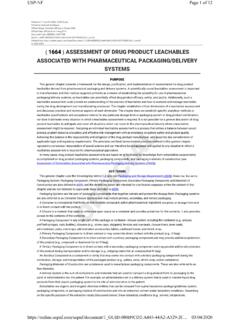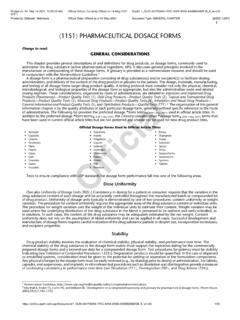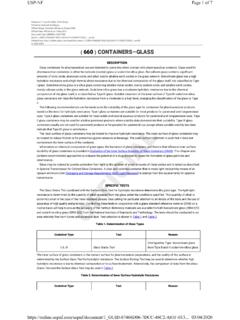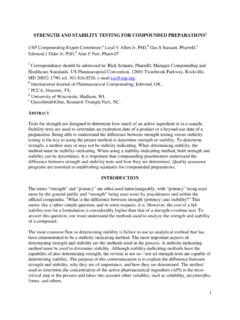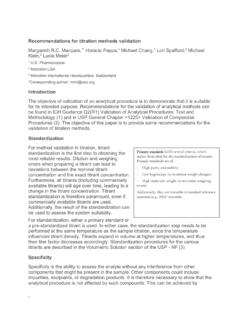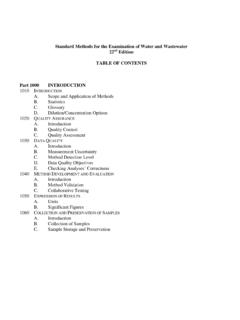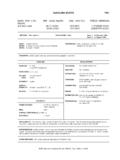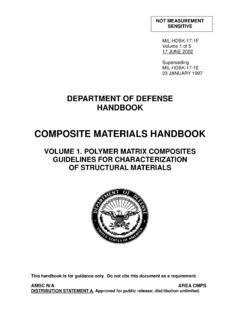Transcription of 1092 THE DISSOLUTION PROCEDURE: DEVELOPMENT AND …
1 1092 THE DISSOLUTION PROCEDURE: DEVELOPMENT ANDVALIDATIONC hange to read:INTRODUCTIONP urposeThis chapter provides a comprehensive approach covering items to consider for developing and validating dissolutionprocedures and the accompanying analytical procedures. It addresses the use of automation throughout the test and providesguidance and criteria for validation . It also addresses the treatment of the data generated and the interpretation of acceptancecriteria for immediate- and modified-release solid oral dosage chapter addresses the DEVELOPMENT and validation of DISSOLUTION procedures, with a focus on solid oral dosage of the concepts presented, however, may be applicable to other dosage forms and routes of administration. For productscontaining more than a single active ingredient, develop and validate the method(s) for each active ingredient.
2 (USP 1-Dec-2020)General recommendations are given with the understanding that modifications of the apparatus and procedures as given inUSP general chapters need to be organization of this chapter follows the sequence of actions often performed in the DEVELOPMENT and validation of adissolution test. The sections appear in the following PRELIMINARY ASSESSMENT (FOR EARLY STAGES OF PRODUCT DEVELOPMENT / DISSOLUTION METHODDEVELOPMENT) Performing Filter Determining Solubility and Stability of Drug Substance in Various Media Stability (USP 1-Dec-2020) Choosing a Medium and Choosing an Apparatus2. METHOD Study Time Data DISSOLUTION Procedure Assessment3. ANALYTICAL Sample Analytical Spectrophotometric Chromatography (USP 1-Dec-2020)4.
3 Medium Sample Introduction and Sampling and Operating Software and Computation of Common Deviations from the Compendial Procedures that May Require Validation5. Specificity/Placebo Linearity and Accuracy/Recovery1 Printed on: Fri May 14 2021, 10:23:39 AM(EST)Official Status: Currently Official on 14-May-2021 DocId: 1_GUID-CE0902BA-77AC-422D-8BF0-A221B5DE6 012_5_en-USPrinted by: Deborah NishikawaOfficial Date: Official as of 01-Dec-2020 Document Type: GENERAL CHAPTER@2021 Repeatability of Intermediate Stability of Standard and Sample Considerations for Automation6. ACCEPTANCE Immediate-Release Dosage Delayed-Release Dosage Extended-Release Dosage Multiple DISSOLUTION Interpretation of DISSOLUTION Immediate-Release Dosage Delayed-Release Dosage Extended-Release Dosage FormsREFERENCESC hange to read:1.
4 PRELIMINARY ASSESSMENT (FOR EARLY STAGES OF PRODUCT DEVELOPMENT / DISSOLUTION METHOD DEVELOPMENT )Before method DEVELOPMENT can begin, it is important to characterize the drug substance (USP 1-Dec-2020) so that the filter, DISSOLUTION (USP 1-Dec-2020) medium, volume of medium, and apparatus can be chosen properly in order to evaluate theperformance of the dosage form. Throughout the chapter, it is assumed that the drug substance is the analyte, unless otherwisestated. The analyte is the compound whose concentration is being measured. In some cases, however, the analyte may be adegradation product or a derivatized product whose concentration is reflective of the DISSOLUTION rate of the drugsubstance. (USP 1-Dec-2020) Performing Filter CompatibilityFiltration is a key sample preparation step in achieving accurate test results.
5 The purpose of filtration is to remove undissolveddrug and excipients from the withdrawn solution. If not removed from the sample solution, particles of the drug substance may (USP 1-Dec-2020) continue to dissolve and can bias the results. Therefore, filtering the DISSOLUTION samples is usually necessaryand should be done immediately if the filter is not positioned on the also removes insoluble excipients that may otherwise interfere with the analytical finish. Selection of the properfilter material is important and should be accomplished, and experimentally justified, early in the DEVELOPMENT of the dissolutionprocedure. Important characteristics to consider when choosing a filter (USP 1-Dec-2020) are material, (USP 1-Dec-2020) type, filtersize, and pore size.
6 The filter that is selected based on evaluation during the early stages of DISSOLUTION procedure developmentmay need to be reconsidered at a later time point. Requalification may need (USP 1-Dec-2020) to be considered after a changein composition of the drug product or DISSOLUTION medium (USP 1-Dec-2020) or after (USP 1-Dec-2020) changes in the quality of theingredients either of the drug product or the DISSOLUTION medium. (USP 1-Dec-2020)Examples of filters used in DISSOLUTION testing can be cannula filters, filter disks or frits, filter tips, or syringe filters. The filtermaterial should (USP 1-Dec-2020) be compatible with the media and the drug substance. (USP 1-Dec-2020) Common pore sizes rangefrom to 70 m, however, filters of other pore sizes (such as m for nanomaterials) (USP 1-Dec-2020) can be used asneeded.
7 In addition to pore size, filter design may affect effective particle size exclusion. (USP 1-Dec-2020) If the drug substanceparticle size is very small ( , micronized or nanoparticles), it can be challenging to find a filter pore size that excludes thesesmall particles. Consider ways to verify that drug particles have not passed through the filter. (USP 1-Dec-2020)Adsorption of the drug substance(s) (USP 1-Dec-2020) by the filter may occur and needs to be evaluated. Filter materials willinteract with DISSOLUTION media to affect the recovery of the individual solutes and must be considered on a case-by-case filter materials exhibit different drug-binding properties. Percentage of drug loss from the filtrate due to binding maybe dependent on the drug concentration.
8 Therefore the adsorptive interference should be evaluated on sample solutions atdifferent concentrations bracketing the expected concentration range. Where the drug adsorption is saturable, discarding aninitial volume of filtrate may allow the collection of a subsequent solution that approaches the original solution filter materials that minimize adsorptive interference can usually be found. Prewetting of the filter with the mediummay be necessary. In addition, it is important that leachables from the filter do not interfere with the analyte. (USP 1-Dec-2020)This condition (USP 1-Dec-2020) can be evaluated by analyzing the filtered DISSOLUTION medium and comparing it with the filter size should be based on the volume to be withdrawn and the amount of particles to be separated.
9 Use of the appropriate (USP 1-Dec-2020) filter dimensions will improve throughput and recovery, and also reduce clogging. Use of a largefilter for small-volume filtration can lead to loss of sample through hold-up volume, whereas filtration through small filter sizesneeds higher pressures and longer times, and the filters can clog used for USP Apparatus 4 need special attention because they are integrated in the flow-through process. Undissolvedparticles may deposit on the filters, creating resistance to the on: Fri May 14 2021, 10:23:39 AM(EST)Official Status: Currently Official on 14-May-2021 DocId: 1_GUID-CE0902BA-77AC-422D-8BF0-A221B5DE6 012_5_en-USPrinted by: Deborah NishikawaOfficial Date: Official as of 01-Dec-2020 Document Type: GENERAL CHAPTER@2021 the case of automated systems, selection of the filter with regard to material and pore size can be done in a similar mannerto manual filtration.
10 Flow rate through the filter and clogging may be critical for filters used in automated systems. Experimentalverification that a filter is appropriate may be accomplished by comparing the responses for filtered and unfiltered standardand sample solutions. The acceptable recovery range for a filtered standard or sample solution when compared with theunfiltered solutions needs to be assessed. (USP 1-Dec-2020) This is done by first preparing a suitable standard solution and a samplesolution. For example, prepare a typical DISSOLUTION sample in a beaker and stir vigorously with a magnetic stirrer to dissolvethe drug load completely. For standard solutions, compare the results for filtered solutions (after discarding the appropriatevolume) to those for the unfiltered solutions.


